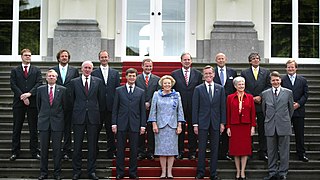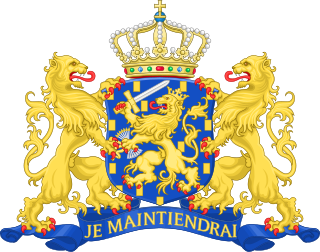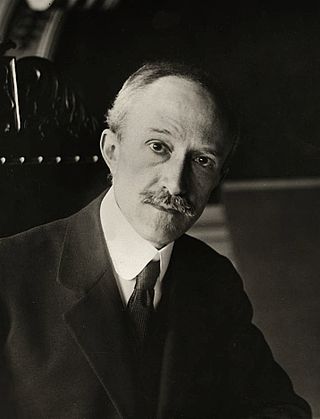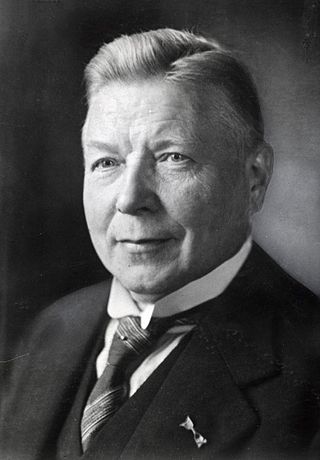
The first Balkenende cabinet was the executive branch of the Netherlands government from 22 July 2002 until 27 May 2003. The cabinet was formed by the Christian-democratic Christian Democratic Appeal (CDA), the nationalistic Pim Fortuyn List (LPF) and the conservative-liberal People's Party for Freedom and Democracy (VVD) after the election of 2002. The cabinet was a right-wing coalition and had a substantial majority in the House of Representatives with Christian Democratic Leader Jan Peter Balkenende serving as Prime Minister. Prominent economist Eduard Bomhoff served as Deputy Prime Minister and Minister of Health, Welfare and Sport, while prominent Liberal politician Johan Remkes served as Deputy Prime Minister and Minister of the Interior and Kingdom Relations.
The Anti-Revolutionary Party was a Protestant conservative and Christian democratic political party in the Netherlands. The party was founded in 1879 by Abraham Kuyper, a neo-Calvinist theologian and minister who served as Prime Minister between 1901 and 1905. In 1980 the party merged with the Catholic People's Party (KVP) and the Christian Historical Union (CHU) to form the Christian Democratic Appeal (CDA).

The Christian Historical Union was a Protestant Christian democratic political party in the Netherlands. The CHU is one of the predecessors of the Christian Democratic Appeal (CDA), into which it merged in September 1980.

Hendrikus "Hendrik" Colijn was a Dutch politician of the Anti-Revolutionary Party. He served as Prime Minister of the Netherlands from 4 August 1925 until 8 March 1926, and from 26 May 1933 until 10 August 1939.

The first Biesheuvel cabinet was the executive branch of the Dutch Government from 6 July 1971 until 9 August 1972. The cabinet was formed by the christian-democratic Catholic People's Party (KVP), Anti-Revolutionary Party (ARP) and Christian Historical Union (CHU), the conservative-liberal People's Party for Freedom and Democracy (VVD) and the social-democratic Democratic Socialists '70 (DS'70) after the election of 1971. The cabinet was a centrist coalition and had a slim majority in the House of Representatives with Protestant Leader Barend Biesheuvel a former Minister of Agriculture serving as Prime Minister. Prominent Catholic politician Roelof Nelissen the Minister of Economic Affairs in the previous cabinet served as Deputy Prime Minister, Minister of Finance and was given the portfolio of Suriname and Netherlands Antilles Affairs, former Liberal Leader Molly Geertsema served as Deputy Prime Minister and Minister of the Interior.

This article gives an overview of Christian democracy in the Netherlands, which is also called confessionalism, including political Catholicism and Protestantism.

Jacob Adriaan Nicolaas Patijn was an unaffiliated liberal Dutch politician who was Minister of Foreign Affairs from October 1, 1937, until August 12, 1939.

Jacob Adriaan de Wilde was a Dutch politician of the Anti-Revolutionary Party (ARP) and jurist.

The Second De Geer cabinet, also called the First London cabinet, was the cabinet of the Netherlands from 10 August 1939 until 3 September 1940. The cabinet was formed by the political parties Roman Catholic State Party (RKSP), Social Democratic Workers' Party (SDAP), Anti-Revolutionary Party (ARP), Christian Historical Union (CHU) and the Free-thinking Democratic League (VDB) following the dismissal of the Fifth Colijn cabinet by Queen Wilhelmina on 27 July 1939. The national unity government became a War cabinet on 14 May 1940 following the German invasion and fled to London. The government-in-exile was dismissed by Queen Wilhelmina on 26 August 1940.

The Fourth Colijn cabinet was the cabinet of the Netherlands from 24 June 1937 until 25 July 1939. The cabinet was formed by the political parties Roman Catholic State Party (RKSP), Anti-Revolutionary Party (ARP) and the Christian Historical Union (CHU) after the election of 1937. The right-wing cabinet was a majority government in the House of Representatives. It was the fourth of five cabinets of Hendrikus Colijn, the Leader of the Anti-Revolutionary Party as Prime Minister.

The Third Colijn cabinet was the cabinet of the Netherlands from 31 July 1935 until 24 June 1937. The cabinet was formed by the political parties Roman Catholic State Party (RKSP), Anti-Revolutionary Party (ARP), Christian Historical Union (CHU), Liberal State Party (LSP) and the Free-thinking Democratic League (VDB) after the resignation of the Second Colijn cabinet on 23 July 1935. The centre-right cabinet was a majority government in the House of Representatives and was a continuation of the previous Cabinet Colijn II. It was the third of five cabinets of Hendrikus Colijn, the Leader of the Anti-Revolutionary Party as Prime Minister.

The Second Colijn cabinet was the cabinet of the Netherlands from 26 May 1933 until 31 July 1935. The cabinet was formed by the Roman Catholic State Party (RKSP), the Anti-Revolutionary Party (ARP), the Christian Historical Union (CHU), the Liberal State Party (LSP) and the Free-thinking Democratic League (VDB) after the 1933 general election. The centre-right cabinet was a majority government in the House of Representatives. It was the second of five cabinets of Hendrikus Colijn, the Leader of the Anti-Revolutionary Party as Chairman of the Council of Ministers.

The First De Geer cabinet was the cabinet of the Netherlands from 8 March 1926 until 10 August 1929. The cabinet was formed by the political parties Roman Catholic State Party (RKSP), Anti-Revolutionary Party (ARP) and the Christian Historical Union (CHU) following the fall of the First Colijn cabinet on 11 November 1925.

The First Colijn cabinet was the cabinet of the Netherlands from 4 August 1925 until 8 March 1926. The cabinet was formed by the political parties General League of Roman Catholic Electoral Associations (AB), Anti-Revolutionary Party (ARP) and the Christian Historical Union (CHU) after the 1925 general election. The centre-right cabinet was a majority government in the House of Representatives. It was the first of five cabinets of Hendrikus Colijn, the Leader of the Anti-Revolutionary Party as Chairman of the Council of Ministers.

The Second Ruijs de Beerenbrouck cabinet was the cabinet of the Netherlands from 18 September 1922 until 4 August 1925. The cabinet was formed by the political parties General League of Roman Catholic Electoral Associations (AB), Anti-Revolutionary Party (ARP) and the Christian Historical Union (CHU) after the 1922 general election. The centre-right cabinet was a majority government in the House of Representatives and was a continuation of the previous Cabinet Ruijs de Beerenbrouck I. It was the second of three cabinets of Charles Ruijs de Beerenbrouck as Chairman of the Council of Ministers.
De Standaard was a Dutch daily newspaper published from 1872 to 1944. It was started by Abraham Kuyper, who was the founding editor, and served as an organ of the Anti-Revolutionary Party. Hendrikus Colijn served as editor from 1922 to 1939.























